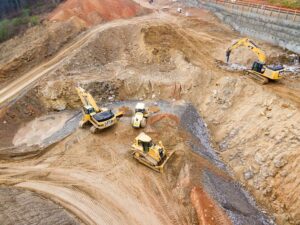Effective Strategies for Construction Project Risk Management
Introduction
Construction projects involve many variables and uncertainties that may derail schedules, inflate budgets, and compromise worker safety if risks are not managed. Effective risk management ensures projects are completed on time, within budget, and free of unexpected issues. This article explores key strategies and tools to identify, assess, mitigate, and monitor risks in construction projects. It explains how team collaboration, data-driven decision making, and proactive planning enhance risk control. By understanding risk factors such as regulatory compliance issues, natural disasters, design imperfections, and contractor errors, project managers can implement robust contingency plans that minimize setbacks. Expert techniques like qualitative and quantitative risk assessments, risk matrices, and best practices are detailed to drive successful outcomes. This resource is intended for general contractors, construction companies, and project stakeholders striving for operational excellence, offering a structured approach to risk management that safeguards project integrity and profitability.
What Are the Key Steps in Construction Project Risk Identification?
Identifying risks in construction begins with a systematic approach involving thorough data analysis and team workshops. Engaging key stakeholders—including field personnel, engineers, safety inspectors, and project managers—in risk identification workshops and using predefined checklists creates a comprehensive risk inventory before hazards escalate.
How to Use Workshops and Checklists for Risk Identification
Workshops bring together experts across disciplines to review each project component. Participants use detailed checklists—developed from past experiences, regulatory guidelines, and industry standards—to systematically examine each task from excavation to finishing. This standardized approach ensures even minor risks, such as regulatory delays or equipment malfunctions, are noted.
Which Expert Interview Techniques Improve Risk Detection?
Expert interviews, including methods like Delphi, brainstorming, and focus groups, are critical for identifying latent risks. These interviews gather insights from experienced professionals who combine historical data with intuition, thereby enhancing detection accuracy when paired with quantitative data.
What Common Risks Should Construction Projects Watch For?
Common risks in construction include design errors, unforeseen ground conditions, labor shortages, equipment failures, regulatory non-compliance, and cost overruns. Environmental challenges such as extreme weather and natural disasters also add significant risk, along with potential safety incidents and delays from supply chain issues. Maintaining detailed risk registers ensures prompt preventive and corrective actions.
How Do You Assess and Prioritize Risks in Construction Projects?

After identification, risks must be assessed and prioritized to allocate resources efficiently. Ranking risks based on statistical likelihood and severity allows project managers to focus on critical threats first. Both qualitative and quantitative methods are used to measure probability and impact.
What Are Qualitative vs. Quantitative Risk Assessment Methods?
Qualitative assessments use expert judgment, risk matrices, and stakeholder input to assign low, medium, or high ratings. Quantitative methods involve numerical analysis, sensitivity analysis, and predictive tools like Monte Carlo simulations. Combining both approaches refines risk priorities with objective measures alongside subjective insights.
How to Evaluate Risk Probability and Impact Effectively
Risk probability is evaluated by reviewing historical data, trend analysis, and industry benchmarks to assign realistic likelihoods. Impact is measured by considering potential delays, cost implications, safety hazards, and reputational damage. Tools such as risk matrix grids help teams visually prioritize risks demanding immediate attention.
Which Tools Support Data-Driven Risk Analysis?
Modern risk management tools and project management software, often integrated with Building Information Modeling (BIM), consolidate historical data, real-time updates, and predictive algorithms. Platforms like Deltek support sensitivity and variance analysis, enabling teams to quantify risk impacts and make informed decisions.
What Are the Best Risk Mitigation Planning Strategies for Construction Projects?
Effective mitigation planning involves a proactive approach that reduces both the likelihood and impact of risks. A well-prepared plan integrates risk response strategies into overall project planning, ensuring contingencies are ready when disruptions occur. Strategic planning, expert consultation, and customized risk management programs form the cornerstone of effective mitigation.
How to Develop Effective Risk Response and Contingency Plans
Effective risk response starts by categorizing risks by priority and impact. Once categorized, responses may involve risk transfer through insurance, avoidance by modifying plans, or acceptance with contingencies in place. Contingency plans outline procedures, communication protocols, assigned roles, and trigger conditions to reduce delays and cost escalations.
What Customized Solutions Improve Risk Mitigation Outcomes?
Customized solutions adapt international best practices to each project’s unique conditions. Examples include advanced safety training, multiple supply chain arrangements, and flexible work schedules to address labor shortages. Scenario planning and digital monitoring tools enhance these solutions, enabling timely interventions as risk factors interact.
How Does a Proactive Approach Reduce Project Delays and Costs?
A proactive approach identifies potential issues before they become critical. By continuously monitoring risk indicators and acting on early warnings, project managers can prevent delays, rework, and unexpected expenses. Regular risk reviews and updated registers lead to higher productivity, improved safety, and better return on investment.
How Can Construction Projects Monitor and Control Risks Continuously?

Continuous monitoring is essential to maintain the effectiveness of risk mitigation strategies. This involves regular tracking, performance evaluations, and quick identification of deviations from planned responses. Ongoing communication among project managers, subcontractors, and stakeholders is crucial for situational awareness and timely strategy adjustments.
What Are the Best Practices for Risk Tracking and Reporting?
Best practices include updating risk registers regularly, holding dedicated team review meetings, and using dashboards that visualize real-time risk status. Automated reporting tools in construction management software, along with standardized metrics such as risk impact scores and exposure values, facilitate clear and consistent communication with stakeholders.
How to Implement Risk Mitigation Strategies During Project Execution
Risk mitigation must be embedded into daily operations. This integration can be achieved by incorporating risk checklists into project protocols, scheduling safety drills, and aligning risk management tasks with project milestones. When risks materialize, pre-determined contingency actions are executed immediately to minimize damage, relying on efficient team coordination and continuous training.
Which Metrics Indicate Successful Risk Control?
Key performance indicators (KPIs) such as reduced incident frequency, timely mitigation tasks, adherence to budget, and improved safety records measure successful risk control. Other metrics include response rates to identified issues and the proportion of mitigated risks compared to initial assessments. These quantifiable measures enable data-driven adjustments to risk management protocols.
Proven Risk Mitigation Planning Strategies for Construction Projects
Expertise combined with data-driven decision making is vital, as it allows project teams to navigate uncertainties with confidence. Reliance on seasoned professionals’ insights, together with robust analytical tools, ensures that risk management is based on reliable data rather than guesswork.
How Does Industry Experience Enhance Risk Management Effectiveness?
Industry experience equips teams with historical context and practical insights that numerical data alone cannot capture. Experienced professionals can anticipate pitfalls by reading subtle warning signs and adapting strategies proactively—particularly in complex projects where standard procedures may not suffice.
What Role Does Data Analytics Play in Construction Risk Decisions?
Data analytics transforms vast project data into actionable insights. Techniques like trend analysis, predictive modeling, and sensitivity analysis quantify risk probabilities and impacts. Integrated dashboards and visualizations enable real-time monitoring, allowing managers to implement corrective actions swiftly and efficiently.
How Can Customized Risk Programs Improve Project Outcomes?
Customized risk management programs are tailored to meet each project’s distinct challenges. By combining industry best practices with project-specific data, these programs ensure higher efficiency, reduced downtime, and improved overall quality. A well-structured program boosts stakeholder confidence and consistently achieves better project results.
What Are Common Challenges in Construction Project Risk Management?

Construction risk management often faces challenges such as team resistance to change, underestimating unforeseen risks, and difficulties maintaining updated risk registers. These challenges typically arise from poor communication, inadequate training, and insufficient integration with overall project planning.
How to Overcome Resistance to Risk Management Practices?
Overcoming resistance requires fostering a culture of transparency and proactive planning. Regular training and clear communication that demonstrate tangible benefits—such as fewer delays and enhanced safety—can encourage stakeholder buy-in. Pilot projects and involving team members in decision making help reduce resistance and promote collaboration.
What Are the Risks of Inadequate Risk Assessment?
Inadequate risk assessment can lead to major setbacks, including cost overruns, safety incidents, and delays. Without proper identification and evaluation, contingency plans may be insufficient, leaving projects vulnerable to unexpected challenges. The resulting contractual disputes, regulatory issues, reputational damage, and loss of stakeholder confidence underscore the need for thorough, ongoing risk assessments.
How to Manage Unforeseen Risks During Construction?
Managing unforeseen risks requires agility and adaptable planning. Projects should include flexible contingency plans, maintain emergency funds, and conduct scenario planning to anticipate non-traditional risks. Clear communication and decision-making protocols ensure that unexpected challenges are addressed promptly. Continuous monitoring, supported by data-driven alerts, further strengthens responsiveness.
How Do Successful Construction Projects Achieve Risk Management Excellence?
Successful projects achieve risk management excellence by integrating robust strategies throughout every project phase. This success results from experienced leadership, innovative data analytics, and a proactive approach that adapts to emerging risks. High-performing projects maintain detailed risk registers, implement reliable response protocols, and perform effective post-project evaluations.
What Are Proven Examples of Effective Risk Management Programs?
Effective risk management programs demonstrate their value by maintaining stable budgets and schedules even amid disruptions. For example, some projects have reduced delay risks by conducting early risk identification workshops and regular risk tracking. The use of advanced risk management software that adapts project plans in real time and detailed post-project audits further exemplifies the long-term benefits of robust risk programs.
How to Measure the Impact of Risk Management on Project Success?
The impact of risk management is measured through KPIs such as adherence to timelines, minimal budget variance, lower safety incident rates, and overall project quality. Tools like risk matrices, scorecards, and performance dashboards provide quantifiable evidence of cost efficiency and operational continuity. Comparing projects with strong risk management against those without clearly shows the significance of systematic risk control.
What Lessons Can Be Learned From Past Construction Risk Failures?
Lessons from past failures emphasize the dangers of insufficient site analysis, the importance of integrating risk management with overall project planning, and the need for continuous monitoring. Failures often reveal overlooked risk factors—such as weather disruptions, labor shortages, and design challenges—and underscore the importance of thorough post-mortem analyses to inform future risk management improvements.
Frequently Asked Questions
Q: What is the first step in identifying risks in a construction project?
A: Organize risk workshops with project stakeholders and use detailed checklists to systematically list hazards, ensuring even minor risks are captured for further analysis.
Q: How can qualitative and quantitative methods be integrated for risk assessments?
A: Qualitative methods, using expert judgment and risk matrices, combined with quantitative predictive models, create a comprehensive risk profile that blends experience with numerical precision.
Q: What tools are commonly used for data-driven risk analysis in construction?
A: Tools such as Building Information Modeling (BIM), risk management software, and platforms like Deltek are used for quantitative analysis, trend evaluations, and scenario planning, aiding in the visualization of risk impacts.
Q: How do customized risk management programs improve construction project outcomes?
A: By tailoring strategies to each project’s unique challenges and incorporating industry best practices with site-specific data, customized programs enhance mitigation efficiency, reduce delays, and lower costs while increasing stakeholder confidence.
Q: What are the best practices for tracking risks during a construction project?
A: Maintaining an up-to-date risk register, using automated dashboards for real-time monitoring, and scheduling periodic review meetings ensure deviations are quickly identified and addressed.
Q: How can project managers measure the success of their risk management strategies?
A: Success is measured using KPIs such as reduced incident rates, budget adherence, timely completion, and improved safety records; these metrics help compare initial assessments with actual outcomes.
Q: What impact does industry expertise have on risk management in construction?
A: Industry expertise provides invaluable insights into potential hazards and effective mitigation strategies, enabling professionals to identify risks that computerized systems might overlook.
Final Thoughts
Effective construction project risk management is achieved through systematic identification, precise assessment, strategic mitigation, and continuous monitoring. The integration of expert knowledge with data analytics transforms uncertain variables into manageable challenges, ensuring projects remain on schedule and within budget. Learning from past failures and fostering a proactive risk culture can sustainably reduce delays and escalated costs. Embracing customized risk management programs will further enhance safety, quality, profitability, and long-term success.


